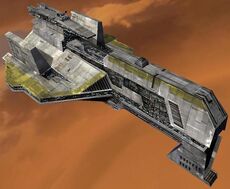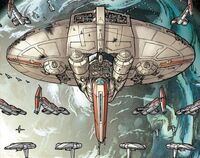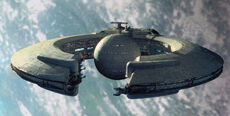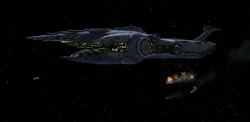| | |

The Keldabe-class was the largest warship of the Zann Consortium's navy.
Battleship was a name widely used for types of capital ship. Often, it was reserved as a term for the largest and strongest warships in a navy, broadly comparable with dreadnaught, but sometimes, smaller vessels in the same navy were described as performing the duties of a peace-keeping battleship. At times, it was synonymous with "warship" and simply described larger combat ships.[1]
History
Republic records

The Cal-class was the last in a long line of battleships, being powered with a hull-running mass-driver cannon.
Even in the Pre-Republic era, large capital ships like the titanic battlecruisers that served in the navy of Xim the Despot were counted on to turn the tide of any battle. [2] [3] Some of the earliest Old Republic era battleships and battlecruisers belonged to the planetary or sector naval forces of such worlds as Coruscant,Alsakan, Corellia, and their respective allies within the Core. [3] Throughout the course of the Alsakan Conflicts, squadrons of great and massive battleships were described to be the guardians of the Core worlds. [3] The prevalence and effectiveness of these larger capital ships varied depending on the technology and the prevailing strategies of the day. [3]
One of the known battleship classes introduced around the year 10,000 BBY, were vessels created in imitation of the long-running planet buster Kumauri Battleship line.[3] This trend culminated with the Cal-class battleship, which was popular with several governments, most notably the Galactic Republic. These battleships were used to intimidate or destroy hostile civilizations, as the Republic aggressively expanded outward into the Galaxy. They were also effectively used as terror weapons during the Tenth Alsakan Conflict. [3]
After the Waymancy Storm of 7,811 BBY, the Republic slowly incorporated new technologies like the squintpipe process, which led to greatly improved turbolasers. [3] By 7,500 BBY, new breakthroughs in armor, shields, hyperdrives, and power generation ushered in a golden age of warship production. Larger capital ships would once more become the mainstays of the Republic military and its individual private sector fleets, as well with dominions and kingdoms located beyond the boarders of the Republic. [3] This battleship era would only come to an end in 2,500 BBY due an economic downturn, which led to fleets being largely comprised of smaller cruisers. [3]
The wars between the Republic and the Sith Empire, as well as with the Mandalorians, were known for their colossal battles involving some of largest capital ships in the history of the Galaxy.[3] Throughout the Great Hyperspace War, the primary combatant ships in both Sith and Republic fleets, were denoted as "battleships".[4][5] During the Great Sith War[6] and the Mandalorian Wars,[7] the Mandalorian factions used Kyramud-type battleships and Kandosii-type dreadnaughts in their fleets. Meanwhile, the Republic maintained fleets of very large and blocky command ships and battleships[8], which slowly became outdated and were eventually replaced with newer warships.[9] The Mandalorian Wars saw the Galactic Republic constructing and fielding the Inexpugnable-class tactical command ships[7] which were sometimes referred to as "battleships."[10] The Republic would go on to build a number of very advanced warships during the Great Galactic War, one of the largest examples being the behemoth Superdreadnought the Star of Coruscant.[11]

The Inexpugnable-class served as command ships and battleships during the Mandalorian Wars.
In the final stages of the New Sith Wars, the term "battleship" for capital ships like the corsair battleship, fast-moving vessels which, along with starfighters, served in a picket/attack role, and provided support for other warships like Sith Destroyers and Hammerhead-class cruisers.[12]
After the devastation wrought by the New Sith Wars, the Republic military was disbanded and reorganized into the Judicial Forces. In an effort to keep the peace, the Ruusan Reformations implemented many restrictions on fleet sizes, armaments, and on the hyperdrives of the larger warships serving in the various Planetary Security Forces around the Galaxy.[3] Generally, warships were limited to being cruisers with a maximum length to 600 meters, though there were some exceptions to these restrictions.[3] Planets and sectors that had direct representation in the Senate were allowed more military allowances, as they strove to impress neighboring systems and to create robust defenses.[3] As time went on new battleships would be constructed for the wealthy planets and sectors of the Republic, while intergalactic organizations built large transports there were capable of being transformed into large warships.[3] In an effort to encourage innovation and the development of new technologies, starship manufactures were also allowed to produce prototype warships or experimental variants of existing classes that could be in excess of the Ruusan restrictions.[3] In the centuries prior to the Clone Wars, the rich and heavily industrialized Core Worlds like Corellia, Humbarine, and Kuat were awash in warships and built fleets centered around powerful multi-kilometer long warships.[13][14][3] During this era, two types of large warships that were among Kuat Drive Yards bountiful catalogue of Star Destroyers, were the 2,500 meter long Procurator-class Star Battlecruiser and the 8,000 meter long Mandator-class Star Dreadnought.[3][14] Kuat would not only use these battleships for their own sector forces, but also sold these warships to other planetary governments and eventually the Republic itself during the Clone Wars.[3] The Clone Wars would then once more usher in an age of large and heavily armed transgalatic warships.[14]
Clone Wars and beyond

The Lucrehulk-class was converted from commercial freighters to battleships, and heavily upgraded during the Clone Wars.
The "battleship" designation was again used by the Trade Federation for the militarized version of their LH-3210 cargo freighter. Though very large ships, and at least sometimes heavily shielded, the original militarized version of these ships was more of a starfighter carrier and battle droid assault ship than a combat warship, with a relatively light defensive armament of quad laser cannons. Later versions used during the Clone Wars, however, lived up to the "battleship" designation with a massive armament of turbolasers.[15][16] During the Clone Wars, the Republic also faced the threat of the battleship Malevolence, Grievous's flagship and the strongest vessel in the Separatist fleet.[17]
Cruisers and battleships
The Home One-type Star Cruiser served as a battleship and command ship.
During the Clone Wars and Galactic Civil War, ships such as the Venator-class, Victory-class and Imperial-class Star Destroyers could be referred to as either "battleships" or "peacekeeping battleships".[18][19]
At the same time, the Venator-class was also contrasted with battleships in the Republic fleet, for which they acted as escorts. Little else is known about these battleships, except that they were heavier in some sense than "medium-weight" warships like the Venator-class.[20] This would be mirrored in the Imperial Navy, with Star Destroyers of the day acting as escorts for larger vessels, like Star Dreadnaughts.[21]
During the Galactic Civil War, the Imperial Navy described ships bigger than Imperial Star Destroyers as its largest battleships, built for the Imperial Navy by shipwrights like Kuat, Rendili and Loronar.[22]
In the Alliance to Restore the Republic, the Mon Calamari MC80 Home One type Star Cruiser Home One served in a battleship role for the Rebels,[23] In the Rebel Alliance and the New Republic, at least one model of Corellian gunship, could be described as a "battleship"[24] or a "ship of the line".[25]
Behind the scenes
The Invincible-class served the Republic for thousands of years, even finding service as a patrol ship under the Corporate Sector Authority.
In real life, the term "battleship" emerged with a precise meaning in the late nineteenth century, as an abbreviation of "line-of-battle ship". It denoted a ship that could fight in the "line of battle", the main fleet formation. The early battleships were contrasted with cruisers, which while at this time were similar in size and speed, but were designed for longer-range patrol missions, and carried less armor. Over the following decades, cruisers became faster, with more speed but less armor than a battleship.
The term dreadnaught (or in UK English, "dreadnought") became synonymous with "battleship" after the introduction of the revolutionary "all-big gun" battleship HMS Dreadnought in 1906. Overnight, all battleship classes prior to HMS Dreadnought were made obsolete, and two modern eras in battleship history would later be considered: Classes made before HMS Dreadnought were referred to as "pre-Dreadnoughts" while classes made afterwards, based on its design-principles, were referred to as "Dreadnoughts". However, this was not a fixed nomenclature, and didn't replace the term "battleship" (for instance, the US Navy referred to its largest ships as Battleships: [1]).
Alongside the dreadnaught, a type of large cruiser with a similar armament of heavy guns was introduced, called the battlecruiser. These retained the traditional of less armor and greater speed, but they quickly came to be perceived as closer cousins to Dreadnoughts than to normal cruisers, a situation that was formalized in the international naval treaties after World War I, which limited the size of cruiser guns.
In the twentieth century, battleships were often only slightly larger than contemporary cruisers, even the limited post-WWI types, and usually smaller than battlecruisers; but they were much heavier in tonnage, due to their massive armor.
The SW galaxy diverges somewhat from the real-world terminology by having a mix of "battleships" and "dreadnoughts" in the same cultures and eras.
Appearances
Sources
Notes and references
- ↑ Star Wars: The Clone Wars: The Visual Guide
- ↑ Han Solo and the Corporate Sector Sourcebook
- ↑ 3.00 3.01 3.02 3.03 3.04 3.05 3.06 3.07 3.08 3.09 3.10 3.11 3.12 3.13 3.14 3.15 3.16 3.17 Cite error: Invalid
<ref>tag; no text was provided for refs namedEGW - ↑ Tales of the Jedi: The Golden Age of the Sith
- ↑ Tales of the Jedi: The Fall of the Sith Empire
- ↑ Tales of the Jedi: The Sith War
- ↑ 7.0 7.1 Star Wars: Knights of the Old Republic: Flashpoint
- ↑ Power of the Jedi Sourcebook
- ↑ Knights of the Old Republic Campaign Guide
- ↑ John Jackson Miller's notes on the name of Courageous. The author also compares them with battleships or ships-of-the-line of Earth's past.
- ↑ Star Wars: The Old Republic - Codex entry Star of Coruscant
- ↑ Darth Bane: Path of Destruction, pp. 85-6.
- ↑ TFN Curtis Saxton interview
- ↑ 14.0 14.1 14.2 Attack of the Clones: Incredible Cross-Sections
- ↑ Star Wars Episode III: Revenge of the Sith
- ↑ Starship Battles Preview 4
- ↑ Star Wars: The Clone Wars - "Rising Malevolence"
- ↑ Star Wars: Incredible Cross-Sections, p. 6
- ↑ Revenge of the Sith: Incredible Cross-Sections, p. 14 (fold-out)
- ↑ Revenge of the Sith: Incredible Cross-Sections, p. 4-5
- ↑ Star Wars: Complete Locations
- ↑ The Illustrated Star Wars Universe
- ↑ The Rebel Alliance Scrapbook, p. 21
- ↑ Darksaber
- ↑ Star Wars 47: Droid World

